Vitamin D bulb for use in the home - or perhaps office
Vitamin D from UVB lamps Update Aug 2012
UVB 4 bulb $425 5 minutes
UVB 1 bulb $150 (with shipping) 5 minutes
There are many artificial sources of UVB - priced from $20 to over $2000
UVB is especially useful if you cannot get out in the sun or cannot swallow capsules or absorb vitamin D
Make a vitamin D lamp using a bulb designed for reptiles
There have been many papers indicating that UV is better than just vitamin D - such as:
UVB better than vitamin D supplements for pet reptiles – March 2010
Mouse MS: UVB but not Vitamin D reduced incidence - April 2010
Evaluation of Vitamin D from Light
Easy and cheap way to get vitamin D all year long = Bulb at home
Costs and minutes vary 3 to 1 due to: skin color, amount of skin exposed, purchase price, bulb life, etc
| Source | cost | $/use 7 | UVA 5 | UVB | Time 4 | Eye protect | Notes |
| Tanning bed - salon | $20,000 | $20.00 | 4.0 | 0.2 1 | 20 | dark goggles | Drive to the salon - skin can wrinkle if too much UVA |
| Tanning bed - home | $2,000 | $1.00 | 2.0 | 0.3 | 30 | dark goggles | Too big for home? - skin can wrinkle if too much UVA |
| Vitamin D lamp | $430 | $0.20 | 1.0 | 3.0 | 5? | dark goggles | no prescription needed |
| SAD 6 | $100 | $0.05 | 0.0 | 0 | never | none 2 | No vitamin D |
| Vitamin D Bulb | $50 | $0.03 | 0.1 | 0.1 | 100 | none 2 | Can read while getting vitamin D 3 |
| Sun | 0 | $0.00 | 1.0 | 1.0 | 10 | none 2 | Excessive sun can cause skin wrinkles and cancer |
Footnotes
1 Law requires reduction of UVB Typically 3% of tanning bed output ==> 12% of sun
2 Full-spectrum light does not need eye protection - the eye avoids and squints in bright light
3 Vitamin D bulb has 1/20 of the UVA per minute of UVB than tanning bed - and very low intensity - so very unlikely to get skin cancer
4 minutes to get 2,000 IU of vitamin D. Tanning beds often have less UVB than the sun
5 UV A tans. Intensity is relative to the sun = 1.0; UV B is needed to produce vitamin D
6 SAD lamps are required by law to have ZERO UV (A or B )
7 Assumes 2000 uses till source needs to be replaced - except salon - where you also must pay for staff - building - etc
The bulbs are very low cost. - and far less expensive/troublesome than going to a tanning salon many times a month
Some places to buy UV bulbs are Amazon Pet store and Reptile UV store http://uvguide.co.uk/ and as well as Google Shopping
Considerations/notes
Should have standard full-spectrum light
Eyes will squint and will tend to look away from the bright light
Not have to protect eyes with UV glasses (actually normal glasses block UV)
UVA will provide feedback, by way of a tan, as to how much vitamin D has been generated (no UVB meter required)
Should not have more UV per day than will generate a slight pinking of the skin the next day
Depending on IU wanted, distance, wattage, reflectors, skin type, and age, the time will vary from 10 minutes to over 200 minutes per day
If it 'pinking,' you should probably flip over or flip end to end every other day to not expose the same skin daily
A 5,000-hour life bulb used 1/2 hour per day, could last for 10,000 days
The easiest-to-use bulb has built-in ballast and a reflector
- Still need an external reflector to aim the light at the skin
Choice of 100 and 160 watts for $35 to $50 on the internet with shipping
My design - shine the bulb over my bed
Can use it for a while napping - be sure to use a timer to wake yourself up or turn it off so as to not harm the skin
Can use it for reading
Be sure to protect the bed cover from fading in the UV

CLICK HERE for Google Product Search to find companies that sell this bulb (100 or 160 watts)
The instructions on the bulb (but not on the internet?) say that it must be mounted VERTICALLY to operate properly
Note 1 - It does not appear to work if you have recently moved it. Seems like waiting for 5 minutes works
Note 2 - It also turns itself off when it overheats. Unplug it and wait for perhaps 30 minutes
What to buy: 100 vs. 160-watt considerations
A 100-watt bulb is smaller, needs less ventilation,
160-watt bulb puts out 60% more light and appears to cost less to purchase
Lamp mounted over the bed - can read about vitamin D while getting some vitamin D
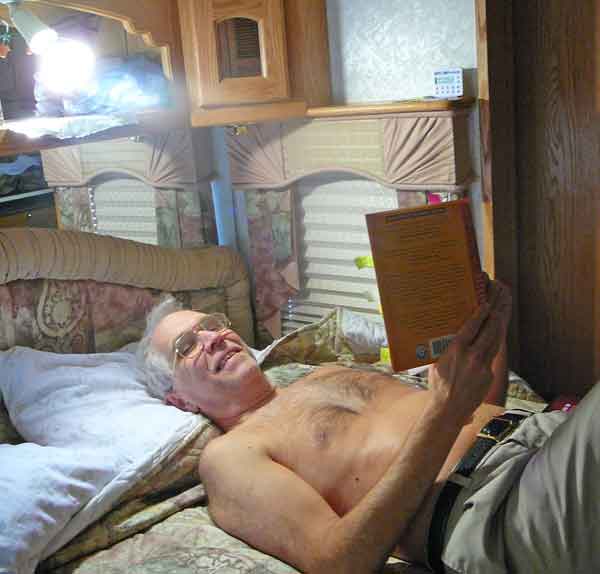
After ordering the above, I found HomePhototherapy with OK prices
Which uses narrow-band UB lamps - which may not provide any tanning (no UVA?) and would probably require wearing glasses
(regular glasses will probably do since regular glasses do NOT transmit UV)

Be sure to take low-cost cofactors when getting lots of vitamin D from any source.
Some cofactors just build strong bones
Some cofactors are needed to balance the body when vitamin D is increased.
Some cofactors appear to help with the utilization of the vitamin D
Some of the files attached to this page
UVB has about 20% of the germ-killing power of UVC - so that is a second use of the bulb
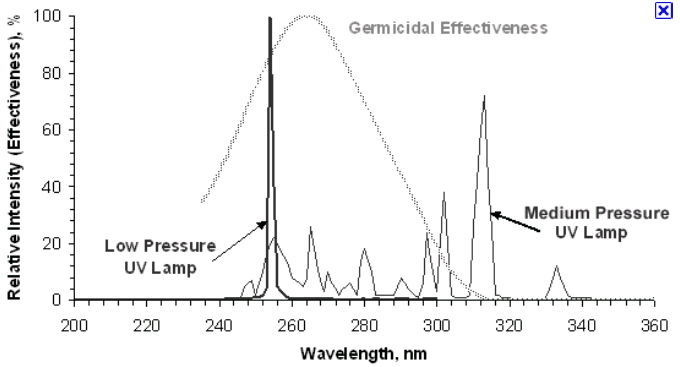
Sunmaster spectrum - had not investigated.

A very large chart about reptiles and UV is attached at the bottom of this page = Reptile - big chart.
Takes too long to download as a thumbnail
Note: Full Spectrum lights are virtually always Full VISIBLE Spectrum Lights
- Full Spectrum bulbs rarely have any UV (non-visible) and thus provide NO VITAMIN D
example: fullsepectrumsolutions emphasize that their lights contain NO UV
SAD bulbs are not legally even able to produce any UV
You can get a tan with a bulb that has virtually no UVB
Update 1 year later (Nov 2011)
Amazon has many UV bulbs to choose from.
I wanted a light that had visible as well as UVB wavelengths so that my eyes would squint and I would not look into the light much.
This type of bulb was also much lower cost than the UV-only bulbs.
I am considering a UV-only bulb for a phase II design, but have not figured out where to put it in our RV
I wanted to get more UV per minute just so I could spend less time in bed.
I will probably stick to existing design which is much very close to true sunshine.
I selected a brand popular with owners of pet reptiles = documented as actually found to contain UV, have a long life, etc.
I then selected the maximum wattage which they made = 160 watts to reduce the amount of time needed to get my vitamin D.
Note: There are many ways to increase the amount of vitamin D you can get from the bulb.
I purchased a Flucker - which currently has poor reviews on Amazon. The Zoo Med product has better reviews but is more expensive.
The bulb purchased has worked well. Have tended to use it about 30 minutes a day at noon during the winter.
Found that using it late at night kept me awake too long.
I estimate that with a homemade reflector, the bulb to concentrate the light onto my skin gives about 1/10 of the UVB that I would get from the summer sun at noon in Seattle.
This estimation is based on calculation, the perceived heat, a small UV detection card that I purchased, and a very slight tan after about 10 sessions.
The reflector (not shown in the photo) also reduces bothering my wife as well as possible bleaching out of the cloth and woodwork.
The mercury vapor inside of the bulb is totally enclosed, just as mercury vapors are inside of standard or compact fluorescent bi; bs
There is no health danger from any of those bulbs unless they break, and even then, it is very minor: see WikiPedia.
Update March 2012
In the 17 months since the page was initially posted:
4000 people have looked at it
300 have downloaded some of the attached files.
7 people have contacted me for more information.
I have found it is not cost-effective
I estimate that I get less than 500 IU per hour from the use of the lamp.
(This was when I was using the 160-watt lamp, having the lamp closer than shown in the photo, and using a deflector to concentrate the light onto my skin)
Since a 5,000 IU capsule of vitamin D costs just 3 cents, the value of my time under the sunlamp is about 1/3 of one cent per hour.
So, I no longer use it.
I am considering an alternate design - a low-power UVB LED that would shine on my face and arms while using a computer.
Found a 1 watt UVB LED - but very new on the market - costs about $500!!
Update Aug 2012
Vitamin D from UVB lamps
UVB 4 bulb $425 5 minutes
UVB 1 bulb $150 (with shipping) 5 minutes
Update Dec 2013
Exo Terra Repti-Glo 10.0 Compact Fluorescent Desert Terrarium Lamp
Amazon $17 26 watts, 10% of output in UVB
Measured UVB light with Vitamin D meter
With good reflector, young skin, and if able to illuminate 10% of the body area, it should produce per minute: 15 IU at 5 inches per and 50 IU at 2.5"
Since it is difficult to imagine illuminating 10% of body area at 2.5", I will assume about 30 IU per minute when the lamp is near, or about 2,000 IU per hour.
Since 2,000 IU vitamin D supplement costs about 2 cents, you have to ask yourself, "Is my time worth 2 cents per hour".
Thoughts for use in the living room/office
It could be mounted in a ceiling fixture with several other bare bulbs: Example 1. Example 2
The fixture must have no glass between the bulb and your skin - Glass absorbs ALL UVB
The other bulbs would provide visible light.
You would probably need to wear glasses to keep the UVB from damaging your eyes.
The following is a wild guess at the output, with lots of assumptions
It appears that ReptileUV Zoo (below) has 1919 microwatts/cm2 @ 12" and 147 microwatts per cm2 @48" = 65 IU/minute
Since this bulb has about 1/5 the output of ReptileUV Zoo (400 instead of 2000 microwatts) - assuming the same 12."
Then this bulb will have about 65/5 = 13 IU/minute - we assume this is per cm2
Assuming you have 100 cm2 of skin exposed (in an office/home setting, wearing lots of clothes), you will get 1300 IU per minute.
This seems far too large - one or more of the assumptions must be in error
The following is a fuzzy spectrum from a PDF on their website
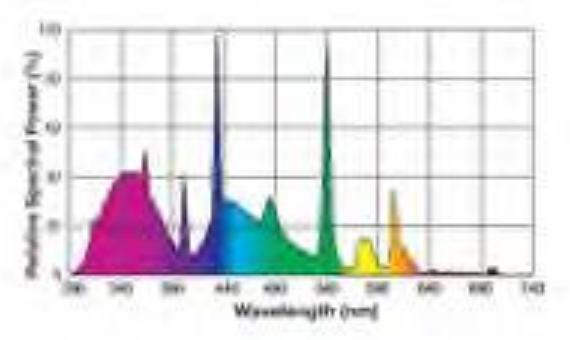
See on the web
Home Tanning information and bulbs
Ott corporation surprisingly does NOT appear to sell any lighting systems which produce UVB
Sally Eauclaire Osborne seems to understand UV vs. non-UV Full-Spectrum Fluorescent Tubes Jan 2011?
UV UK Guide to Reptile lighting - a favorite - see graphs below
Sperti UV only $425 - MUST wear some form of glasses - they lack visible light, which causes the eyes to squint.
Promolife has a variety of UV lamps, including Sperti
SummerTan has a variety of UV lamps
A comparison of the UV-B irradiance of low-intensity, full-spectrum lamps with natural sunlight Dec 2009
SunArc has some nice pages: introduction to Phototherapy Charts of UBV lamp spectrum lamps which they sell
http://uvbnarrowband.com/ appears to have a nice overview of many UVB lamps
See also Vitamin D Life
UVB added in classroom reduced cavities, increased height, increased academics. etc
Vitamin D from low-cost UVB lamps is updated on this page
Vitamin D from psoriasis lamps, tanning beds, and the sun – Jan 2012
Ways to increase the amount of vitamin D you get from UV or the sun: suntan oil, reflectors
Tanning from Wikipedia May 2010
Do UVA and UVB affect the body in different ways Yes: UVA tan, UVB ==> Vitamin D
Lots of UVB or exposed skin did not increase vitamin D generated – Nov 2010
Weekly UV almost doubled elderly Vitamin D levels – Dec 2010 just 2 minutes a week
Reptiles ate as well with all UV sources – Jan 2011
- chart of vitamin D level vs. different bulbs - seems strange; a bulb which produces the least UVB produced the most vitamin D
Increased UVB intensity did not increase vitamin D generated – Nov 2010
- There may be some limit as to how much vitamin D the body will produce over a several-day time period
Notes
from Minutes in the Sun for 1000 IU Skin percentages: Face 3.5%, neck 2%, trunk 26%, hands 6%, arms 14%, legs 14%, thighs 18%.
Have added reflectors to increase the light getting to the skin
The average distance from the bulb to body = 30"
You can decrease by about 40% the amount of 'bulb time" needed by using suntan oil
Notes on the use of UV bulbs in the office
Could augment or replace the standard lighting
Somewhat more costly to install and use than conventional lighting
Since there is so little UV and it is a natural spectrum, it appears that there is no concern about causing damage to the eyes
Bulb will probably add heating - perhaps do not use it in the summer.
Might start using UV bulbs for employees with dark skins
Might start using it for people who get little sunlight, such as those:
work a night shift
work underground
work in submarines
work far from the equator
live in prison Moscow prison to install tanning beds – Nov 2010
Discarded the idea of using an 18" UV tube
It does not have enough intensity for 5 minutes of use, but apparently, it is enough for reptiles who can bathe in it for hours a day.
Many studies have shown that humans require a minimum intensity of UV to generate any vitamin D in the skin.
This has been referred to as the 'vitamin D winter.'
Would require glasses
Based on my fear/ignorance, I have decided not to use that low-intensity light source.
Also, the 18' tubes would have required a much much longer time to get the same amount of vitamin D, assuming that it produced enough to generate any.
10X longer due to lower intensity and another 5X longer due to less skin illuminated
30 minutes x 150 = 4500 minutes = 187 hours
Update Dec 2011
There have been several questions about the smaller, lower-cost tubes
Checked the Zilla bulb (PDF at the bottom of page) as an example,
It has just 50 microwatts/square cm at 12", which is less UVB than the bulbs have at 48"
Some graphs from UV UK Guide to Reptile lighting
Note how quickly the light intensity changes with distance
Decreasing the distance by 2X, from 40" to 20", increases the intensity by 3.6X
Note: Light sources lacking reflectors would have had increased 4X (R squared)



Vivariam lighting has the following graph of UV transmission
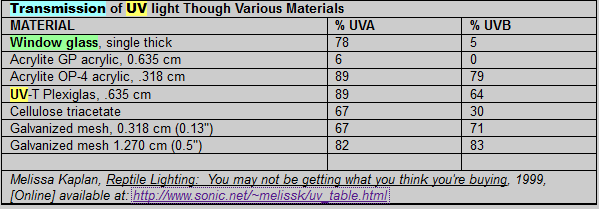
Plants get the most energy from blue and red light - not much in between
from my hydroponic gardening
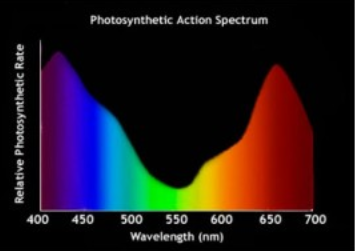
Short url = http://tinyurl.com/vitaminduv
